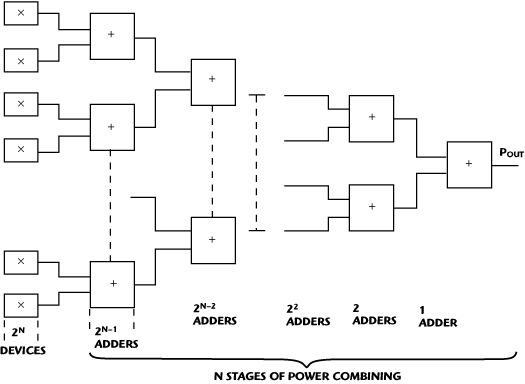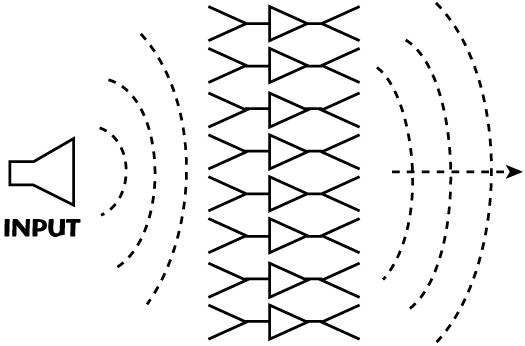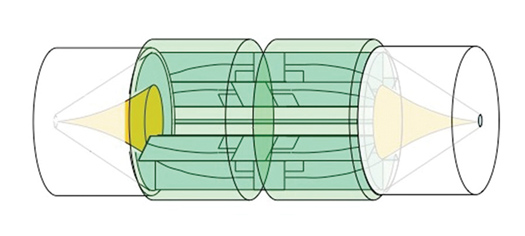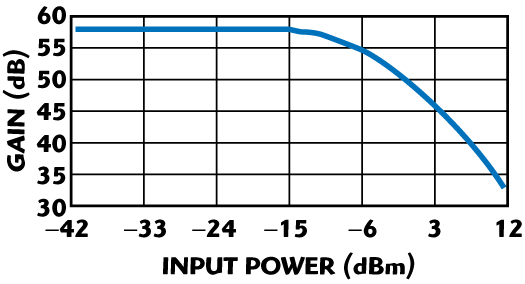 As the second decade of the twenty first century approaches, the digital frontier continues to encroach on what was once considered to be the bastion of the analog domain. There is still, however, a critical need for microwave and RF high-power and low-noise amplifiers for the transition between the system and the ether. Components with more bandwidth and efficiency, higher power, better noise figure or pulse response, lower spurious and more compact size continue to be required, especially by the defense industry, for various highly specialized applications.
As the second decade of the twenty first century approaches, the digital frontier continues to encroach on what was once considered to be the bastion of the analog domain. There is still, however, a critical need for microwave and RF high-power and low-noise amplifiers for the transition between the system and the ether. Components with more bandwidth and efficiency, higher power, better noise figure or pulse response, lower spurious and more compact size continue to be required, especially by the defense industry, for various highly specialized applications.
Historically, RF and microwave amplifiers (along with many microwave circuits in general) were considered too complex and variable to be cost-effectively produced using “conventional” circuit assembly techniques. CAP Wireless has been at the forefront in addressing many of these needs, and has developed a unique technology that unites an innovative combining structure with state-of-the-art monolithic microwave integrated circuit (MMIC) power devices, providing the optimum method of achieving multiple element power combining.

Fig. 1 In a conventional binary planar combiner, the loss becomes too high when combining a large number of amplifier cells.
The unique, patented Spatium™ technology, which incorporates a coaxial antipodal finline structure within a proprietary spatial combining architecture, provides a breakthrough product that offers the stability of solid-state amplifiers with exceptionally broad bandwidth and high power. Classical planar combining networks suffer increasing loss and size as the bandwidth and number of combined devices increase (see Figure 1). The result is that the practical attainable bandwidth when combining a large number of devices is typically limited to 3:1, and, ultimately, a point of diminishing returns is reached as the combining loss approaches the gain of the combined devices.

Fig. 2 The innovative Spatium spatial power combining technology provides parallel identical channels so the loss is the same as for one channel.
The Spatium platform is largely frequency-independent. Parallel identical channels minimize combining loss, which is the same as for one channel (see Figure 2). Bandwidth is limited only by individual device characteristics, mechanical tolerances and size constraints. Power is limited only by device characteristics, thermal dissipation and the physical quantity of devices that can fit in the architecture.
The result is that numerous combinations of power and bandwidth are possible simply by changing the devices. The Spatium engine is compatible with a large number of available MMICs, enabling the circuit topology to provide a highly manufacturable platform that leverages component commonality between different models. This eliminates time-consuming re-designs for each variation and increases unit-to-unit repeatability, resulting in significant time-to-manufacture cost savings for customers.
What is Spatial Combining Technology?
Spatial power amplification is the method of coherently combining the power of many amplifying devices using free space or air as the power dividing/combining medium within a guided wave structure. This method is often referred to as quasi-optical combining.
The earliest known use of the technology is pre-World War II, when, in its most basic form, it was used for tubes and dipole antennas. Substantial research and development efforts were undertaken in the mid-1990s at several universities, including the University of California at Santa Barbara (UCSB). CAP’s Spatium technology springs from work done by chief technology officer Pengcheng Jia for his PhD degree as part of UCSB’s spatial combining development program. CAP’s R&D efforts were begun in response to customer demand for an amplifier architecture that could provide, in a compact package, the reliability and ruggedness associated with solid-state power amplifiers (SSPA) and the signature low thermal-noise characteristic of solid-state performance, and could also support moderate to high power levels and operate linearly with minimal harmonic and intermodulation distortion over very broad frequency ranges, all at a competitive price.
How Does it Work?
The Spatium technology achieves its remarkable performance through an amalgamation of innovation, sophisticated modeling and implementation. The arrangement can be visualized as an oversized coaxial guided wave structure. A tapered center conductor transitions from the traditional subminiature version A (SMA) coax connector to a larger center conductor. Once the enlarged radius coaxial line is reached, multiple antipodal finline antenna elements arranged radially around the center gather all the microwave energy across a wide frequency spectrum, and transition the gathered signals to several microstrip transmission lines.

Fig. 3 Spatium structure.
Each microstrip line feeds a MMIC power amplifier housed in a 20 GHz resonance-free ceramic package, where the signals are simultaneously amplified by equal amounts. The amplified signals out of the MMICs are launched back onto microstrip lines, which then couple to output antipodal finlines back into a coaxial waveguide, where the fields coherently combine. The output signal transitions through a tapered coaxial line back to an SMA connector, providing the high output power levels. Figure 3 shows a simplified pictorial representation of the structure. Figure 4 shows the completed mechanical structure that makes up the “engine.”

Fig. 4 Spatium physical implementation.
The uniformity of the MMICs and the intrinsic structure enables the maintenance of nearly identical phase and amplitude variation through all amplification channels, resulting in high power combining efficiencies. Typical combining efficiency across the 2 to 20 GHz band is < 0.5 dB loss with 16-way combining. As mentioned previously, the loss is independent of the number of combined elements, unlike a corporate structure where the losses increase as the number of combined elements increases.
Because the combining losses are low and power is not wasted in the combining scheme, the operational efficiencies are maximized, resulting in lower heat dissipation and less prime power for a given power level. Also, because of the high number of combined elements, the root mean square (RMS) phase noise of the amplifier is less than that of a single comparable device and significantly lower than what might be expected from a traveling wave tube amplifier.

Table 1
Spatium Features and Benefits
The novel Spatium power combining structure shows great promise for revolutionizing the microwave power amplifier. Applications traditionally dominated by traveling wave tube (TWT) or vacuum electronic device (VED) solutions, such as test and measurement, electronic warfare, electronic counter measures and simulators, can now take advantage of all the associated preferable performance attributes of solid-state implementation, including higher reliability, low-voltage operation for safety, longer life, low thermal noise characteristics for improved signal-to-noise ratios and improved linearity. Table 1 quantitatively compares the Spatium amplifier capability with alternative amplifier technologies.
Linearity
TWT amplifiers have a power rating defined by their peak power output capacity and must be operated substantially (typically six or more dB) below their rated saturated output power for linear performance. Solid-state amplifiers, on the other hand, have power ratings defined by their one or two dB gain compression point and can be operated at or near their rated one dB compression level to achieve linear performance. This means, for example, that at a given power level below 50 W, a solid-state amplifier rated at 50 W P1dB will offer equal or better linear performance compared to a TWTA rated at 200 or more watts of saturated power.

Fig. 5 Typical power saturation curve for 100 W, nonlinearized TWTA.
Figure 5 illustrates a typical power saturation curve for a 100 W, non-linearized TWTA. It can be seen that a peak power level is obtained at around 0 dBm of input drive level, and that further increasing the input level actually causes the output power level to decrease. In the corresponding gain curve, illustrated in Figure 6, the TWTA gain at the maximum output power level is already significantly compressed compared with its small-signal gain.

Fig. 6 In a corresponding gain curve, the TWTA gain at the maximum output power level is significantly compressed compared with its small-signal gain.
Supply Voltage
The Spatium amplifier technology takes advantage of available microwave semiconductor power device technology by combining high multiples (> 16) of devices to achieve moderate output powers. Because this device technology operates from low (< 28 VDC) supply voltages, rather than the high (> 1 kV) supply voltages typically associated with TWTAs, it can operate from readily available, lower cost power supplies without risking the safety of personnel. Power supply design complexity is substantially reduced, associated mean time between failures (MTBF) is considerably higher and safety concerns are minimized.
To further increase the reliability of a solid-state amplifier system, one can take advantage of the availability and sophistication of low voltage supplies to implement a degree of redundancy, which ensures continued operation in the event of partial failure.
Warm Up
Spatium amplifiers require no warm-up time to reach their optimum performance. TWTAs may require several minutes to stabilize and reach peak operation capability.
Reliability
Spatium amplifiers use solid-state devices, which inherently provide high reliability. Published TWTA reliability appears to be substantial as well, but noted exceptions are failures due to the high voltage supplies used for powering the tube. In addition, the parallel nature of the Spatium amplifier adds a multiplicative factor to the inherent reliability as it eliminates a single point failure mode.
Bandwidth
The Spatium offers up to decade bandwidth, surpassing current tube technology by a factor of two.
Soft Fail
The Spatium amplifier uses multiple combined devices, providing functionality at a reduced power level in the event of a single device failure.
Robust Construction
Spatium amplifiers, because they are solid-state devices, are inherently mechanically rugged. TWTAs, on the other hand, are subject to damage by abuse or shock because they are highly mechanically tuned, vacuum-encapsulated-by-glass devices.
AM-PM Conversion
Spatium amplifiers exhibit little AM-PM conversion to their rated 1 dB compression point. TWTAs must typically be backed off 16 dB or more from their rated saturated power level before achieving minimal AM-PM.
Noise Figure
Spatium amplifiers have an inherently low noise figure, typically no more than 8 dB. TWTAs often have noise figures ranging from 30 to 35 dB, potentially limiting the dynamic range of measurements.
Environmental Concerns
TWTAs often use beryllium oxide (BeO) material as a thermal management material. BeO dust is a known carcinogen and health hazard.
Conclusion
CAP Wireless Spatium broadband spatially combined products obsolete some of today’s power amplifiers and make the unachievable a reality. By efficiently combining large numbers of amplifiers, Spatium PAs deliver an inherently low loss structure, graceful degradation on failure, low-voltage operation, solid-state reliability and good phase noise characteristics. The Spatium technology is uniquely positioned to provide the optimum solution for applications such as electronic counter measures (ECM), laboratory instrumentation and electromagnetic compatibility/electromagnetic interference (EMC/EMI) test, as well as narrower band applications like radar, microwave imaging and satellite communications. Spatium amplifiers excel when extremes of bandwidth and power are needed and, at the same time, provide all the characteristics required for today’s demanding defense and commercial communications application challenges, at a realistic cost.
CAP Wireless Inc.,
Newbury Park, CA (805) 499-1818,
www.capwireless.com/spatium.
RS No. 304
